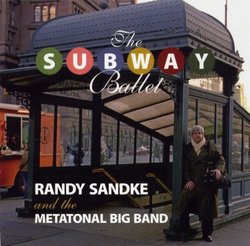A big band light on its toes
N. Dorward | Toronto, ON Canada | 10/02/2006
(4 out of 5 stars)
"Definitely not your usual big band disc. This is indeed a piece of music written for a ballet (though so far it remains unchoreographed, I gather); the narrative takes you across New York via the subway in the 1980s, following a thwarted, love-at-first-sight romance between a punk rocker & a girl (with her mother looking on in horror). As the story progresses through different districts of New York you get to hear the musics of the city's many different cultures. My favourite moments are the "Dance of the Hasidic Diamond Merchants", which features the hard-blowing klezmer clarinettist David Krakauer; the "Dance of the Downtown Punks" (Sandke actually manages to make a convincing merger of big-band jazz and punk-rock, believe it or not), and the one straightforwardly swinging track, "Dance of the Midtown Career Women". There's also a nice nod to the Ellington/Strayhorn balladry of "Star-Crossed Lovers" in the lovers' feature, the "Pas de Deux".
This isn't quite as strong a disc as Sandke's previous big-band effort _Outside In_, in part because solo space is more constrained; that said, there are excellent if brief spots for Wycliffe Gordon, Steve Bernstein (on his slide trumpet!), Scott Robinson and especially Ted Nash (who is equally fine on alto sax & flute), not to mention Sandke himself.
There are four bonus tracks at the end from a 1988 session; the main interest for me was that these offer a taste of Sandke's "other" ax, electric guitar. (During the 1970s, physical problems forced him to switch for a while from trumpet to guitar.) There are two rather jarring & bemusing tracks with lots of drum machine & synth; the really valuable inclusions, though, are two pieces with Jim McNeely & Gerry Niewood, including a steaming organ blues, "Red Hook Blues". It probably wasn't a great idea to stretch the CD's running time with the bonus tracks--aside from their similarly showcasing Sandke's "experimental" side, they're totally unrelated to the ballet score--but they do have their moments."


 Track Listings (18) - Disc #1
Track Listings (18) - Disc #1